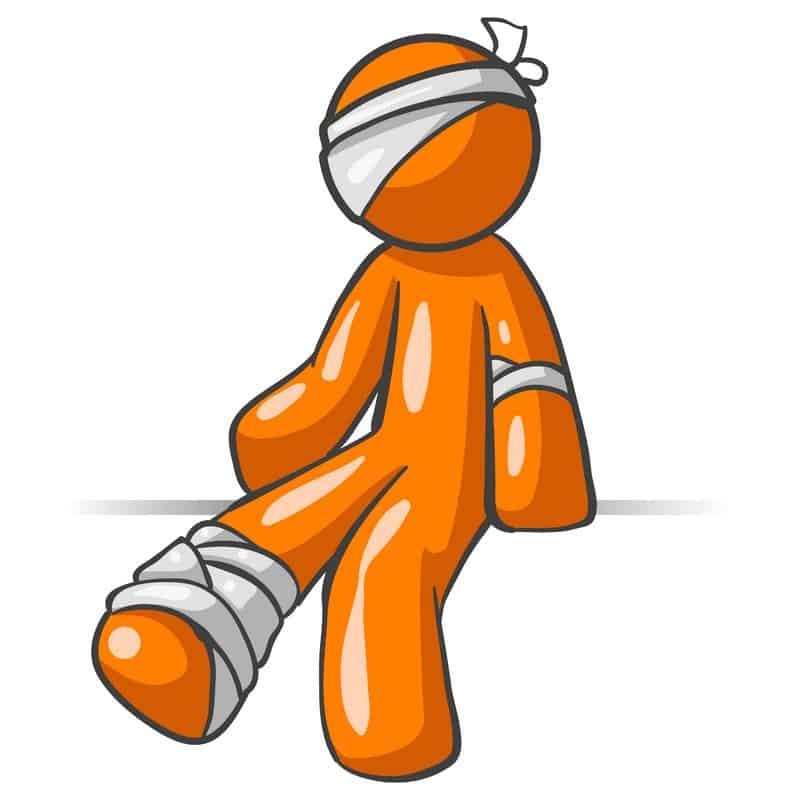When Injured, Do This

The older you get, the smarter you need to be about fitness and exercise. The potential for injury moves in the same direction as age. Develop a strategy for staying injury free and for healing once injured. You’ll be well served to employ the tools, techniques and the flexibility of mind to shift to less intense or rehabilitative exercise.
 I’M SITTING in a café typing this, which wasn’t the plan for this Sunday morning. The plan was to sprint some stairs followed by some push-ups and pull-ups.
I’M SITTING in a café typing this, which wasn’t the plan for this Sunday morning. The plan was to sprint some stairs followed by some push-ups and pull-ups.
Can you spell… “F_R_U_S_T_R_A_T_I_O_N”?
Yes, the coffee is good at this high-end coffee place in fair Sausalito, but I’m supposed to be sucking my guts, sprinting 30 seconds up the stairs, walking 90 seconds down; repeat eight times till legs are wobbly, the ground looks welcoming, and I mutter to myself repeatedly,
“Why is an old boy like me doing this?”
Well, today I’m not on the stairs as scheduled, and the reason I’m not is the subject of this post, which is:
How to deal with exercise-based injuries.
Yeah, I’m not on the stairs because I woke up this morning with a sore right leg Achilles tendon. Somewhere in my thirties I ruptured my left Achilles tendon while playing that miserable game, basketball, the very same sport that caused me to rupture two lower disks in my back when 21 years young.
There was a time in my feckless youth when I’d power through injuries. Not any more. Paid that price. So when my tendon is sore, I back off and recalibrate what will constitute exercise for the day, if I exercise at all.
If I don’t do this, what is likely to happen is that what’s now sore or weak will become dysfunctional. That means no exercise at all for perhaps a long time. That means all that hard work — particularly those stair sprints — that got me at the fitness level now enjoyed is thrown out the window.
It’s not worth it.
Sometimes, when your body gives you the alert, you need to step back from the usual, hard charging exercise routine.
Here’s my main point:
Fitness is a long-term game and it has its ebbs and flows.
Consistent with that point, let me again underscore that:
If you don’t back off when on the verge of injury, or actually injured, it’s almost certain that at some point you’ll have no other choice but to suspend all exercise and watch your fitness level revert to some repugnant level that you long ago swore you’d never allow yourself to retreat to again.
This assertion, I assert, is triply true as you get past 40 years of age. At this point in life, rest, recovery and nutrition are more important than the effectiveness and rigor of the exercise.
Keep the following three things in mind as you try to maintain your fitness as the years float by, or get it back after years of desk jockeying:
1. Injuries take longer to heal, so greater vigilance is required to keep them from happening.
2. Weakness in your physical structure, such as alignment, core strength and mobility will have a greater tendency to cause an injury.
3. The tools, techniques and flexibility of mind to shift to less intense or rehabilitative exercise must be acquired and used.
Today, by dint of my Achilles soreness, the stairs were denied me, but I’ve taken #3 to heart and am prepared.
Later today, I will substitute the stairs for a yoga session that fiendish friends have called, “Garmanetics”. Yeah, they’re a strange bunch, but what that term is getting at is that I made up an exercise routine that works for my injured body.
It works because it’s:
- Deliberative in its movements so I have less a chance of exacerbating an injury,
- Aerobic because there’s no place to stop, unless you really need to catch your breath,
- Muscle-building because you’re both lifting your own body weight and the dumbbells I’ve incorporated into the yoga (and thus the name “Garmanetics”), and
- Mobility-enhancing due to the stretching of the yoga postures.
No, it will not give me the same human growth hormone pump that the high intensity interval training of the stairs, nor tax my muscles in the same way as do push-ups and pull-ups.
[Watch Boost Your Human Growth Hormone In 20 Minutes]But, when done, I’ll feel the bliss out of a hard yoga session and my body will take yet another step toward being injury-free and integrated.
Certainly, that’s worth doing.
Yep.
P.S. As I’ve said before somewhere on this site, mobility enables every other physical thing. Without it, you’ll be limited in how strong you can be, how resilient you can be from injuries, and the speed with which you heal.
Lucky you, there’s a great source to be mobile and repair yourself – it’s MobilityWod, the brainstorm of physical therapist Kelly Starrett. The hundreds of videos he has posted cost you nothing to view. Do yourself a favor go check it out and use the search function there to find Kelly’s prescription to heal and strengthen whatever needs fixing on your body.
Last Updated on July 24, 2020 by Joe Garma


